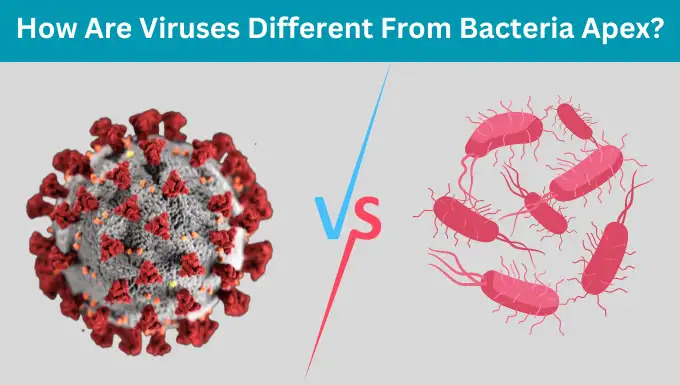In the vast realm of microorganisms, viruses and bacteria stand as two distinct entities, each harboring unique characteristics that define their existence and impact on the world around us. While often lumped together due to their microscopic nature, viruses and bacteria are fundamentally different in structure, function, and behavior.
In this comprehensive exploration, we will delve into the remarkable dissimilarities that set these microorganisms apart, understanding how viruses are different from bacteria at the apex of biological complexity.
How Are Viruses Different From Bacteria Apex?
Basic Structural Variations
At the very core, the structural differences between viruses and bacteria form the foundation of their dissimilarity. A virus is an acellular particle consisting of genetic material (DNA or RNA) encased in a protein coat known as a capsid. This minimalist structure lacks the complex cellular machinery characteristic of living organisms. Conversely, bacteria are unicellular, prokaryotic organisms possessing a more intricate cell structure complete with a cell wall, plasma membrane, cytoplasm, and genetic material in the form of a single circular DNA molecule.
Reproductive Mechanisms: The Apex Divergence
The disparity in reproductive mechanisms between viruses and bacteria is stark, further emphasizing their distinctiveness. Viruses are obligate intracellular parasites, lacking the necessary cellular machinery for reproduction. Instead, they invade host cells, hijacking their genetic machinery to replicate and assemble new viral particles. In contrast, bacteria are capable of independent replication through binary fission, where a single cell divides into two identical daughter cells, each capable of carrying out all vital life functions.
Classification Complexity
The complexity of classifying viruses and bacteria reveals another layer of their dissimilarity. Bacteria are classified based on various factors such as shape, staining properties, and metabolic characteristics, resulting in a well-defined taxonomy. On the other hand, viruses defy conventional classification due to their acellular nature and reliance on host cells for replication. This leads to a unique system of classification based on factors like genetic material, capsid structure, and mode of replication.
Antibiotics vs. Antiviral Agents
The apex of contrast between viruses and bacteria lies in the realm of treatment. Antibiotics, which target specific structures or functions within bacteria, have been instrumental in managing bacterial infections. However, these antibiotics are ineffective against viruses due to the lack of cellular structures to target. Instead, antiviral agents are designed to disrupt viral replication processes, hinder attachment to host cells, or boost the host’s immune response. This fundamental difference in treatment underscores the distinct challenges posed by viral and bacterial infections.
Size Matters: Microscopic Disparity
Size serves as another differentiating factor between viruses and bacteria. Bacteria are relatively larger, typically ranging from 0.5 to 5 micrometers in size, allowing them to house essential cellular components. In contrast, viruses are significantly smaller, often measuring between 20 and 400 nanometers. Their diminutive size restricts them to carrying only genetic material and a few essential proteins, necessitating their reliance on host cells for replication.
The Immune System Conundrum
Understanding how viruses are different from bacteria at the apex of the immune response sheds light on their distinctive impact on the host. Bacteria trigger immune responses through recognition of their unique cell wall components, such as lipopolysaccharides. In contrast, viruses evade detection due to their intracellular nature, making it difficult for the immune system to distinguish between viral and host cells. This evasion contributes to the chronic and recurrent nature of viral infections, which often necessitate vigilant vaccination strategies.
Evolutionary Origins
The evolutionary trajectories of viruses and bacteria reveal yet another layer of dissimilarity. Bacteria are considered among the earliest life forms on Earth, with evidence of their existence dating back billions of years. They played a pivotal role in shaping the planet’s early atmosphere and continue to inhabit a myriad of environments. In contrast, the origins of viruses remain shrouded in mystery. Some theories suggest that viruses may have evolved from fragments of cellular genetic material, while others propose they predate cellular life, representing a distinct branch of the tree of life.
Ecological Impact: A Tale of Two Microbes
The ecological impact of viruses and bacteria diverges drastically due to their differing roles in ecosystems. Bacteria are renowned for their crucial roles in nutrient cycling, decomposition, and symbiotic relationships. They influence plant health, animal digestion, and environmental equilibrium. Conversely, viruses primarily influence population dynamics, particularly in microbial communities. Viral infections can lead to population crashes among bacteria, shaping microbial diversity and ecosystem stability.
Genetic Complexity and Adaptability
The genetic complexity and adaptability of viruses and bacteria provide further insights into their dissimilarities. Bacteria possess a more extensive genetic repertoire, allowing for rapid adaptation to changing environmental conditions and even horizontal gene transfer between species. In contrast, viruses exhibit a higher mutation rate, contributing to their ability to evade host immunity and adapt swiftly to new hosts. This adaptability has significant implications for disease emergence and spread.
Parting Note:
In the intricate tapestry of life, viruses and bacteria stand as distinct threads, woven together by their microscopic nature yet unraveled by their remarkable differences. From structural disparities to reproductive mechanisms, treatment challenges, and ecological impacts, these microorganisms showcase the apex of biological diversity.
Understanding how viruses are different from bacteria at the apex not only enriches our comprehension of the microbial world but also underscores the critical roles each plays in shaping the intricate balance of life on Earth.
Note:
Are you a content creator? If yes then we welcome bloggers & they can submit a guest post to our famous blog for free, just search in google, we are on top of search engine “ write for us + travel”, You will find “Lifeyet News”.
 Lifeyet News Lifeyet News
Lifeyet News Lifeyet News





